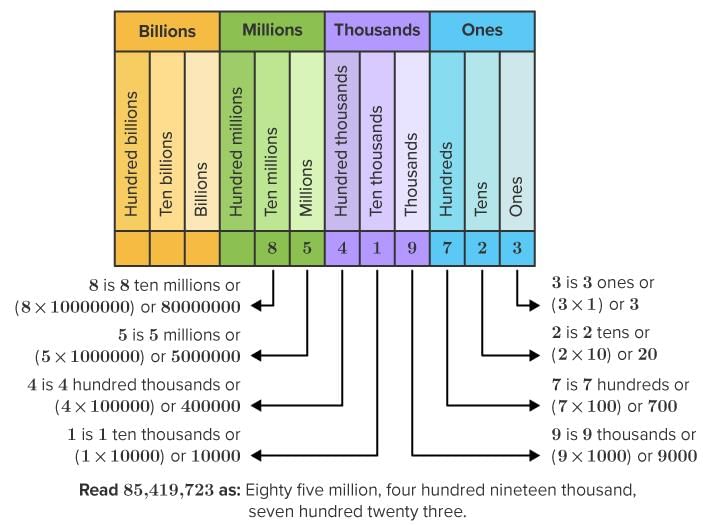More Than a Million Chapter Notes - Class 5 PDF Download
| Table of contents |

|
| What is System of Numeration? |

|
| Indian System of Numeration |

|
| International System of Numeration |

|
| Relationship Between Indian and International Systems |

|
What is System of Numeration?
A numeral system is a writing system for expressing numbers; that is, a mathematical notation for representing numbers of a given set, using digits or other symbols in a consistent manner. The same sequence of symbols may represent different numbers in different numeral systems.
Indian System of Numeration
In the Indian system, numbers are grouped into different periods: Ones, Thousands, Lakhs, and Crores. Each period is separated by commas. Here is the structure:
- Ones: This includes the places for Ones, Tens, and Hundreds.
- Thousands: This includes the places for Thousands and Ten Thousands.
- Lakhs: This includes the places for Lakhs and Ten Lakhs.
- Crores: This includes the places for Crores and Ten Crores.
Place Values in the Indian System:
- Ones (1)
- Tens (10)
- Hundreds (100)
- Thousands (1,000)
- Ten Thousands (10,000)
- Lakhs (1,00,000)
- Ten Lakhs (10,00,000)
- Crores (1,00,00,000)
- Ten Crores (10,00,00,000)

International System of Numeration
In the International system, numbers are grouped into periods of three digits each. These periods are Millions, Thousands, and Ones. Each period is separated by commas. Here is the structure:
- Ones: This includes the places for Ones, Tens, and Hundreds.
- Thousands: This includes the places for Thousands, Ten Thousands, and Hundred Thousands.
- Millions: This includes the places for Millions, Ten Millions, and Hundred Millions.
Place Values in the International System:
- Ones (1)
- Tens (10)
- Hundreds (100)
- Thousands (1,000)
- Ten Thousands (10,000)
- Hundred Thousands (100,000)
- Millions (1,000,000)
- Ten Millions (10,000,000)
- Hundred Millions (100,000,000)
Writing Numbers in Both Systems
Example 1: The Number 5,673,899
In the Indian System:
- Written as: 56,73,899
- In words: Fifty-six lakh seventy-three thousand eight hundred ninety-nine
In the International System:
- Written as: 5,673,899
- In words: Five million six hundred seventy-three thousand eight hundred ninety-nine
Example 2: A Larger Number 5,678,932,156
In the Indian System:
- Written as: 5,67,89,32,156
- In words: Five crore sixty-seven lakh eighty-nine thousand thirty-two hundred fifty-six
In the International System:
- Written as: 5,678,932,156
- In words: Five billion six hundred seventy-eight million nine hundred thirty-two thousand one hundred fifty-six
Using Large Numbers
Large numbers are often used in contexts like population, financial data, and large-scale measurements.
Example: Population
The population of a country as of 31 March 2016 was 1,210,193,422.
In the International System:
- Written as: 1,210,193,422
- In words: One billion two hundred ten million one hundred ninety-three thousand four hundred twenty-two
In Expanded Notation:
- 1 x 1,000,000,000 (One Billion)
- 210 x 1,000,000 (Two Hundred Ten Million)
- 193 x 1,000 (One Hundred Ninety-Three Thousand)
- 4 x 100 (Four Hundred)
- 2 x 10 (Twenty)
- 2 x 1 (Two)
Relationship Between Indian and International Systems
To understand the relationship, we compare the equivalent values in both systems:
- 100,000 (Indian: 1 Lakh) = 1,00,000
- 1,000,000 (Indian: 10 Lakh) = 10,00,000
- 10,000,000 (Indian: 1 Crore) = 1,00,00,000
- 1 Billion = 1,000,000,000
- 1 Trillion = 1,000,000,000,000
Expanded Notation of Numbers
Example: The Number 5,678,901
In Expanded Notation:
- (5 x 1,000,000) + (678 x 1,000) + (9 x 100) + (0 x 10) + (1 x 1)
- In words: Five million six hundred seventy-eight thousand nine hundred one
Example: The Number 18,764,325
In Expanded Notation:
- (18 x 1,000,000) + (764 x 1,000) + (3 x 100) + (2 x 10) + (5 x 1)
- In words: Eighteen million seven hundred sixty-four thousand three hundred twenty-five
Key Points to Remember
- 100,000 = 1 Lakh
- 1 Million = 10 Lakhs
- 10 Million = 1 Crore
FAQs on More Than a Million Chapter Notes - Class 5
| 1. What is the Indian System of Numeration? |  |
| 2. What is the International System of Numeration? |  |
| 3. What is the relationship between the Indian and International Systems of Numeration? |  |
| 4. How do you convert numbers between the Indian and International Systems of Numeration? |  |
| 5. Why is it important to understand both the Indian and International Systems of Numeration? |  |













